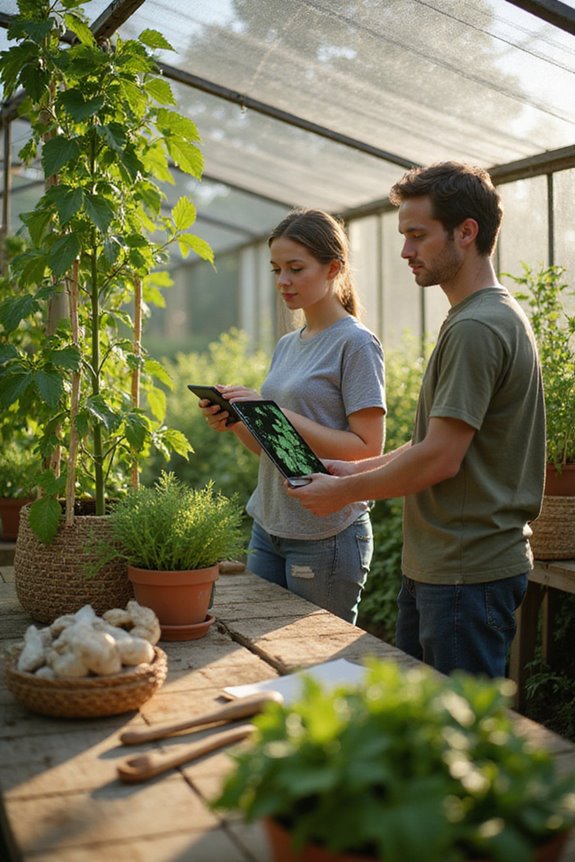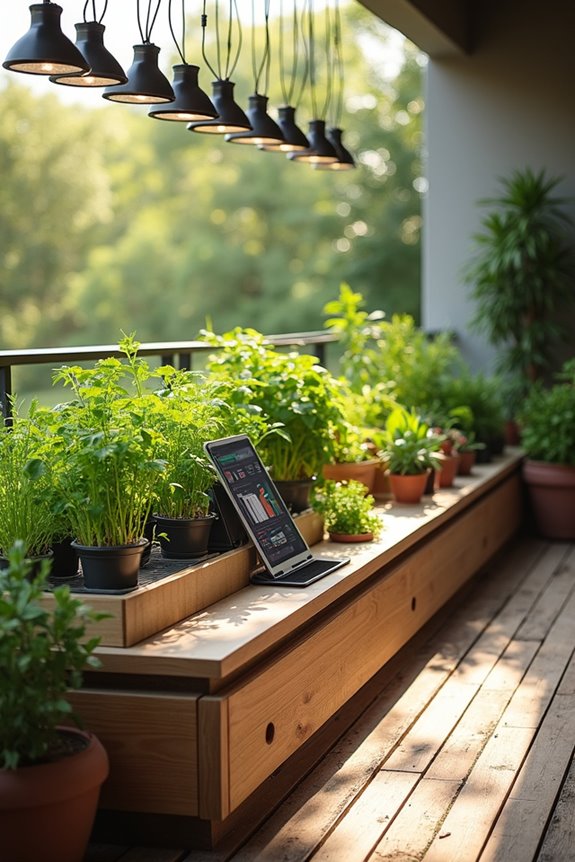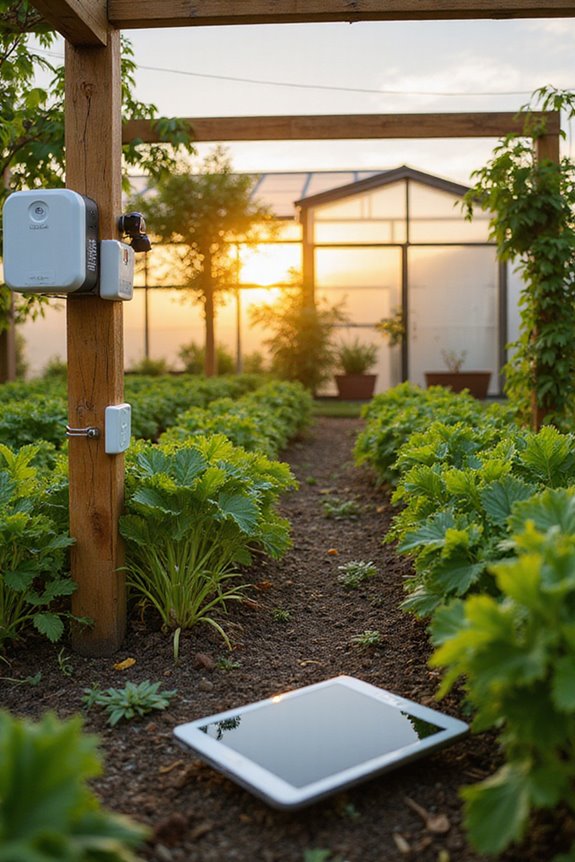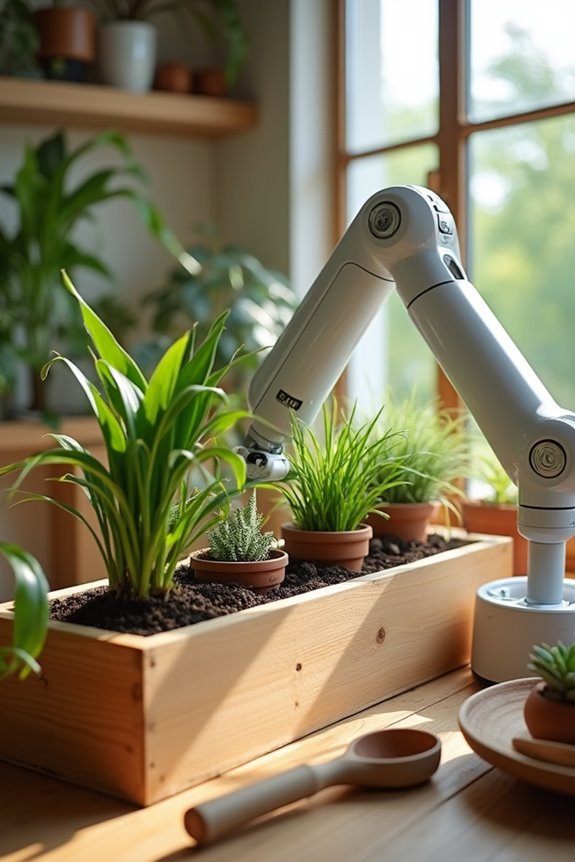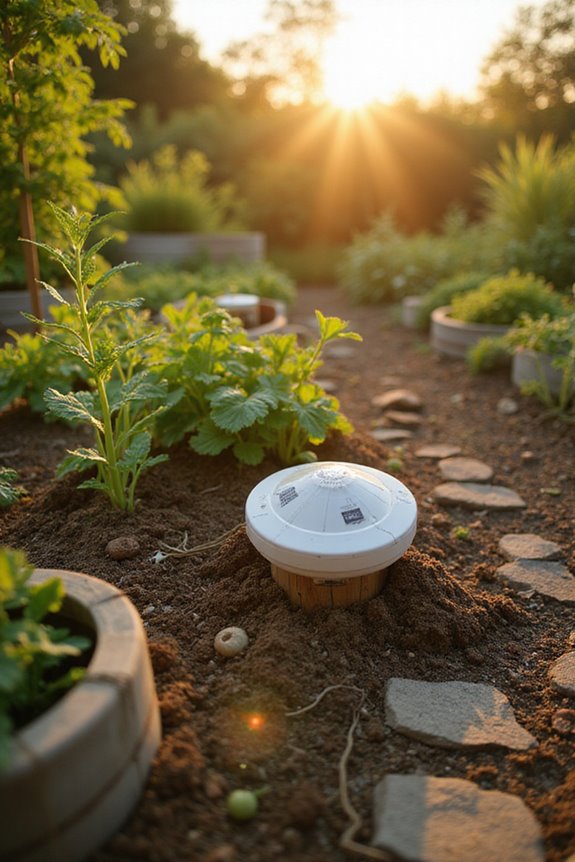To use AI for plant diagnosis, we can follow a few simple steps. First, we take high-quality images of plants, especially focusing on any signs of disease. Next, we apply image processing techniques to refine these images. After that, we utilize AI models, like CNNs or improved YOLO, to identify and diagnose the problems. Mobile apps can provide instant results and tailored care advice, enhancing our farming decisions. There’s much more to explore in AI and agriculture.
Key Takeaways
- Capture high-resolution images of plants using digital cameras or drones for effective analysis and diagnosis of diseases.
- Apply image preprocessing techniques to reduce noise and enhance the quality of images for better segmentation and feature extraction.
- Utilize AI models like CNNs and YOLOv3 to accurately identify and localize infected areas in plants.
- Implement mobile applications for instant diagnosis and tailored management instructions based on real-time plant health data.
- Access diverse datasets and employ data augmentation to improve model training and enhance disease detection capabilities.
Understanding AI Techniques in Plant Disease Diagnosis
Understanding AI techniques in plant disease diagnosis is essential for modern agriculture. First, we capture high-resolution images of plants using digital cameras or drones. Then, image preprocessing steps like noise reduction and resizing help enhance important disease features. This process allows us to focus on infected areas through segmentation, isolating them from healthy tissues.
Next, we explore feature extraction. By identifying traits such as texture, color, and shape, we can classify diseases more accurately. Techniques like histogram equalization can improve contrast, making symptoms easier to spot. Finally, data augmentation helps us build a robust dataset by introducing variations. Together, these steps create a solid foundation for diagnosing plant diseases effectively, making our agricultural practices more efficient.
The Role of Mobile and On-the-Spot AI Applications
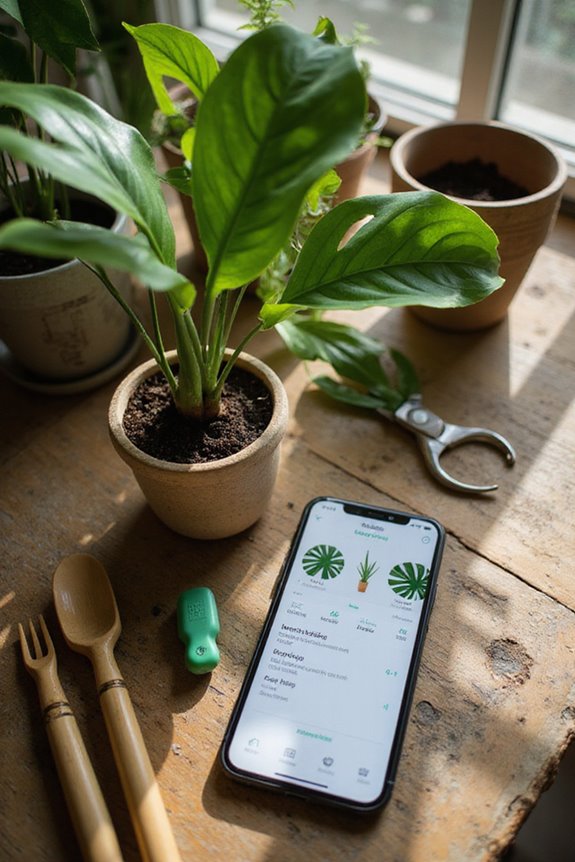
Mobile and on-the-spot AI applications are transforming how we diagnose plant diseases. With mobile diagnostics, we can now identify thousands of species and diseases using our smartphones. These apps deliver real-time insights, enabling us to make faster decisions in the field—up to 80% quicker than traditional methods.
- Instant Diagnosis: We get immediate feedback on plant health, including management instructions tailored to our specific needs.
- User-Friendly: Designed for on-the-spot use, these apps allow us to easily capture images and receive quick results, even in remote areas.
- Integration of Data: They combine expert knowledge with real-time weather data, enhancing our understanding of disease risks.
Together, we can embrace these advancements for healthier plants and more productive farming.
Advantages of Implementing AI in Agriculture
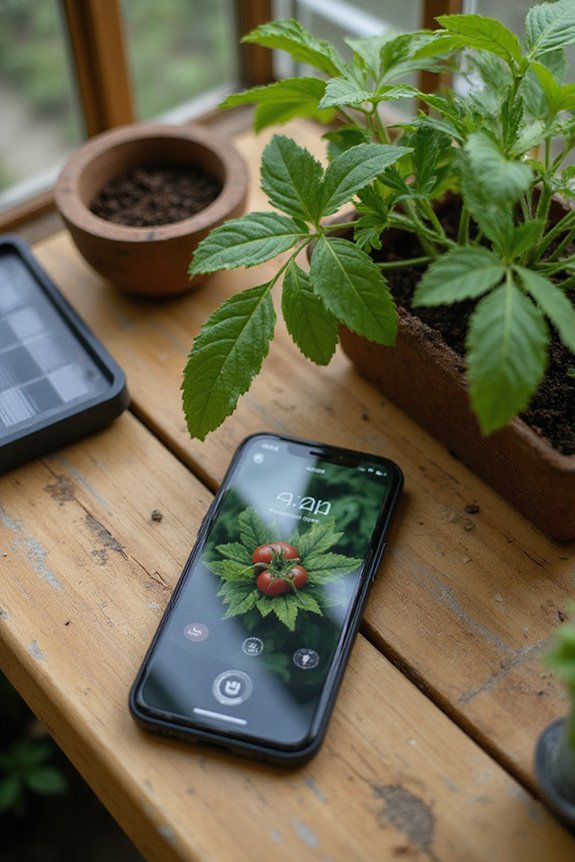
Implementing AI in agriculture brings numerous advantages that can markedly enhance our farming practices. First, we benefit from cost savings and labor efficiency. AI automates tasks like irrigation and crop monitoring, reducing our reliance on manual labor and lowering expenses.
Second, AI supports sustainable practices through precision agriculture. By integrating data from various sources, we can make better decisions about irrigation and fertilizer use, minimizing our environmental impact.
Additionally, AI enhances crop resilience by enabling early detection of diseases and pests. This proactive approach helps us protect our yields effectively. Furthermore, incorporating drought-tolerant plants can further optimize water usage and improve sustainability in agricultural practices.
Key Data Sources and Datasets for AI Models
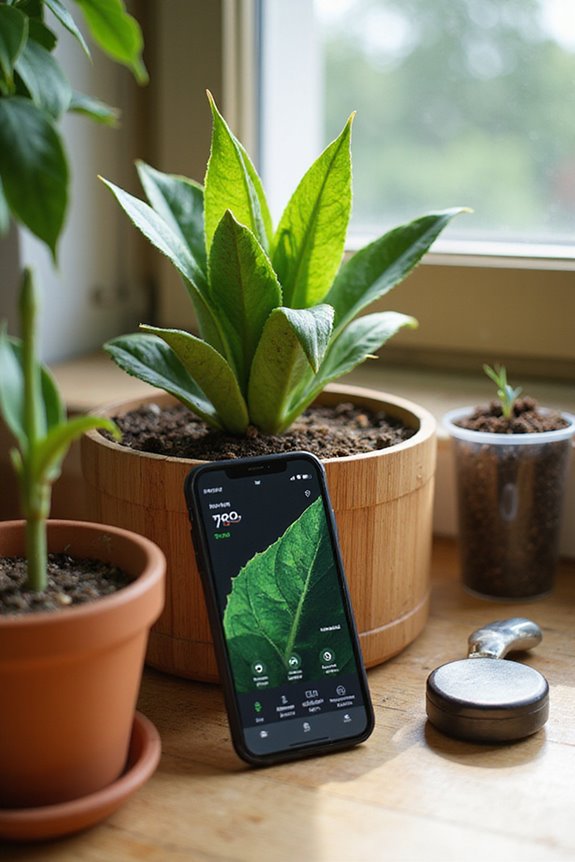
In agriculture, data is a powerful tool for diagnosing plant health issues. Key datasets help us understand and detect diseases effectively. Here are some important data sources:
- CCMT Dataset: Contains over 102,000 images across 22 plant classes, including cashews and maize.
- Benchmark Dataset: Features various plants from Bangladesh, ensuring data diversity.
- Kaggle New Plant Diseases Dataset: Offers a wide range of images, though details are limited.
Dataset validation is essential. Many images are reviewed by experts for accuracy. We can also enhance our datasets through techniques like data augmentation, which expands our image collections. By using diverse data sources, we can create robust AI models that perform well in real-world applications, ultimately improving plant disease diagnosis.
Specific AI Models and Methodologies for Disease Detection
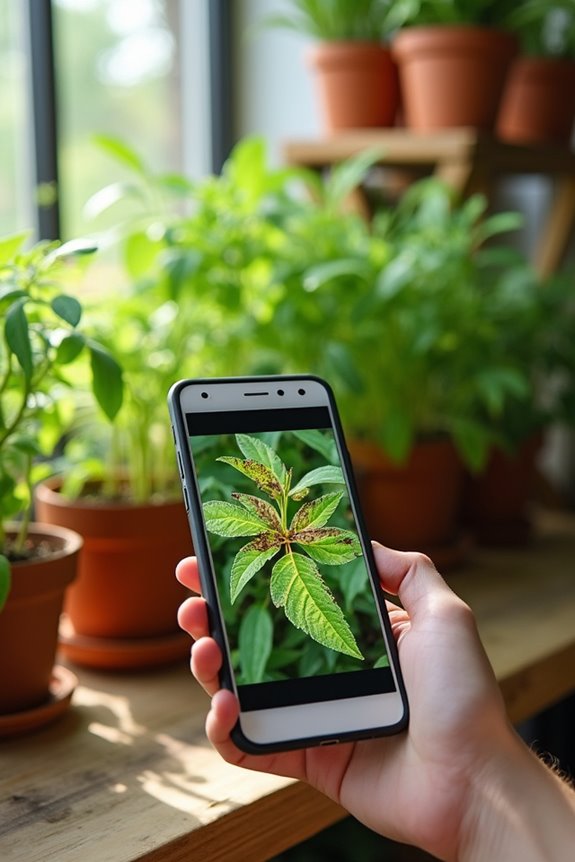
When it comes to diagnosing plant diseases, several key artificial intelligence (AI) models and methodologies stand out.
- CNN Architectures: Models like VGG-16 and ResNet-50 excel in detecting diseases, achieving accuracies over 95%. They utilize data augmentation and transfer learning to enhance performance across various crops.
- Object Detection: Improved YOLOv3 helps localize disease spots in real-time, ensuring precise interventions.
- Vision Transformers: These models capture global context, improving identification accuracy of complex disease patterns.
- Federated Learning: This method allows collaborative training across farms, preserving data privacy while boosting model generalization.
- UAV Integration: Combining AI with UAVs enables large-scale monitoring, enhancing real-time detection of plant diseases.
Together, these technologies create a robust framework for effective plant disease diagnosis.
Challenges Faced in AI Plant Diagnosis
Diagnosing plant diseases using AI isn’t without its hurdles. We face challenges like noise reduction, where irrelevant background elements complicate image segmentation. This interference makes it tough to isolate diseased regions from healthy ones. Environmental variability also plays a role, as AI models often use consistent lab images instead of diverse field conditions.
Data imbalance is another issue, with limited high-quality datasets, making it hard to train effective models. Sensor limitations can affect image quality, which impacts diagnosis accuracy. We also struggle with model interpretability; AI often feels like a “black box,” which can reduce trust among farmers. Finally, deployment challenges arise when trying to integrate AI smoothly into existing farming practices. Each of these hurdles requires our attention as we advance AI in plant diagnosis.
Future Directions for AI in Agriculture
As we explore the future of AI in agriculture, we see exciting possibilities that can transform farming practices. One significant direction is the support of regenerative agriculture. AI can analyze data to help reverse the damage caused by industrial farming. This guarantees healthier ecosystems and better yields.
Additionally, AI is essential for climate adaptation. It creates predictive models that help crops withstand changing weather patterns.
Some future trends include:
- Generative AI: This synthesizes complex datasets into actionable insights.
- Strategic Planning: AI enhances agricultural planning with data-driven recommendations.
- Sustainable Practices: AI promotes practices that are both effective and environmentally friendly.
Together, these innovations can lead to a more resilient and sustainable agricultural future.
Integrating AI With Iot for Enhanced Monitoring
Integrating AI with IoT for enhanced monitoring can greatly improve our agricultural practices. By leveraging sensor integration, we can gather real-time data from soil moisture, temperature, and humidity sensors. This data feeds into AI algorithms that use data analytics to provide actionable insights. For instance, machine learning can predict environmental trends, helping us make informed decisions before issues arise.
Moreover, cloud platforms allow for remote access to this essential information, enabling us to monitor our crops from anywhere. With early detection of diseases and pests, we can act swiftly to protect our plants. Ultimately, combining AI with IoT not only enhances productivity but also promotes sustainable practices in our farming communities.
Frequently Asked Questions
What Types of Crops Can AI Diagnose Effectively?
Did you know AI can identify corn diseases with over 98% accuracy? Together, we can also tackle tomato blight and other crops, enhancing our ability to manage plant health and guarantee sustainable farming practices.
How Does AI Handle New or Unknown Plant Diseases?
When it comes to handling new or unknown plant diseases, we leverage data analysis and machine learning techniques. These tools help us identify anomalies, adapt quickly, and continuously improve our understanding of emerging threats in agriculture.
Are There Specific AI Apps Recommended for Home Gardeners?
If we want to revolutionize our gardening experience, let’s explore amazing gardening apps! These tools offer incredible plant identification capabilities, ensuring we can tackle any plant issue with confidence and connect with fellow plant enthusiasts.
Can AI Detect Diseases in Organic Farming Practices?
Absolutely, we can leverage machine learning for disease prediction in organic farming! By utilizing AI, we enhance our ability to detect issues early, fostering healthier crops and a more sustainable farming community we all belong to.
How Cost-Effective Is Implementing AI in Small-Scale Farming?
When it comes to implementing AI in small-scale farming, we can save costs through technology integration. By working together, we can harness these advancements and reap the benefits, ensuring everyone’s thriving in the agricultural community.

